Learn to make the classic shortbread cookies recipe with this easy guide. These cookies are buttery and melt in your mouth. They mix cornstarch, confectioners sugar, flour, and butter into a dough that’s simple to shape.
They’re perfect for holiday trays. Each bite is a mix of sweetness and flaky texture. It’s a treat that’s loved by both beginners and experts.
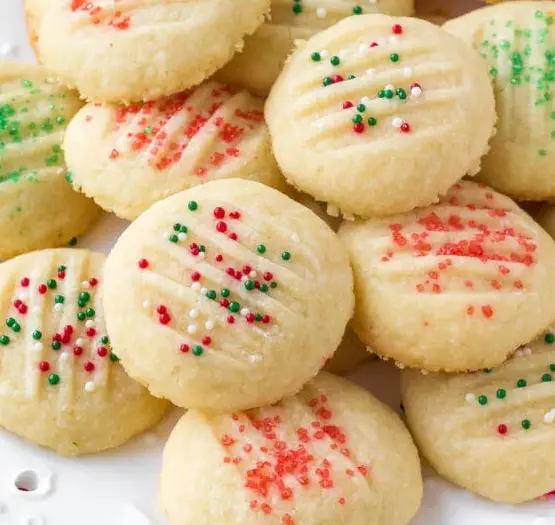
These buttery shortbread cookies are made with just four ingredients. They’re a family favorite. Bake them at 325°F for 15-18 minutes.
Make sure to space the dough balls 2 inches apart. Their layers are crisp yet creamy. They’re great with tea or coffee.
This guide shows 14 creative twists on shortbread. You can add lemon zest or fir-infused sugar. There are gluten-free almond flour versions and festive cranberry additions.
These recipes mix tradition with new ideas. Learn to make cookies that stay fresh for months when frozen. This way, you can enjoy holiday cheer all year.
The Rich History of Shortbread Cookies
Scotland has loved shortbread for over 900 years. These scottish shortbread cookies started as a way to use leftover dough. Now, they are a buttery treat we all enjoy.
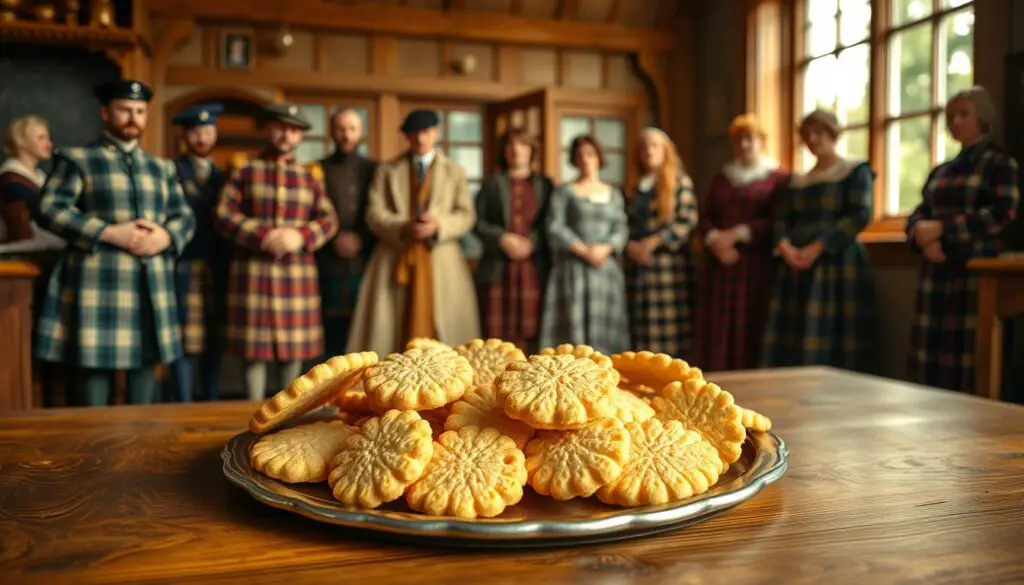
Scottish Origins and Royal Connections
In the 16th century, Mary, Queen of Scots made “Petticoat Tails” popular. These triangular cookies were named after their skirt-like shape. Shortbread became a luxury item due to its butter content.
Even today, Scottish bakers stick to a 1:2:4 sugar, butter, and flour ratio. This formula is followed by bakers like Orkney’s Jarlsbera.
How Shortbread Evolved Through the Centuries
- 12th century: Crisp baked dough scraps became “biscuit bread.”
- 17th century: Sugar’s availability turned it into a sweet, aristocratic treat.
- 19th century: Industrial advancements made it accessible, with regional twists like Shetland’s rice flour-based versions.
- Modern era: Today, chefs innovate with vegan butter and over 30 flavor variations, yet the traditional shortbread recipe remains a cultural anchor.
Why Shortbread Remains a Global Favorite
Shortbread is loved worldwide, from Scotland to Mexico and Argentina. Its simplicity lets flavors stand out. Even with global twists, its heritage stays strong.
Whether enjoyed at Yule or with espresso, shortbread connects us to history. It shows that some treats are timeless.
What Makes Classic Shortbread Cookies Special
The classic shortbread recipe has been loved for centuries. It’s known for its buttery taste and delicate mix. Made with just flour, butter, and sugar, it offers a crumbly texture that melts in your mouth.

The secret is in the 3-2-1 ratio: 3 parts flour, 2 parts butter, and 1 part sugar. For example, use 12 oz flour, 8 oz butter, and 4 oz sugar. High-quality butter, like Kerrygold’s 82% butterfat, adds depth without being too strong.
- Unsalted butter ensures control over salt levels
- Granulated sugar keeps sweetness subtle
- Room-temperature ingredients mix evenly for consistent texture
“The best shortbread sings with quiet luxury—no bells, just butter and patience.”
Chilling the dough for 30+ minutes helps prevent it from spreading. Baked at 300°F until the edges turn golden, these cookies are tender yet firm. They can be shaped into various forms, like fingers or rounds.
Classic shortbread is a timeless treat. Its simplicity allows for creativity, showing that less is more in flavor. Ready to learn why this cookie has been a favorite since medieval Scotland? Let’s explore the importance of each ingredient next!
Essential Ingredients for Perfect Shortbread Cookies Recipe
The best shortbread cookies recipe begins with key ingredients. These elements create a soft, flavorful treat. Quality is key, as each part balances the buttery taste with a light texture.
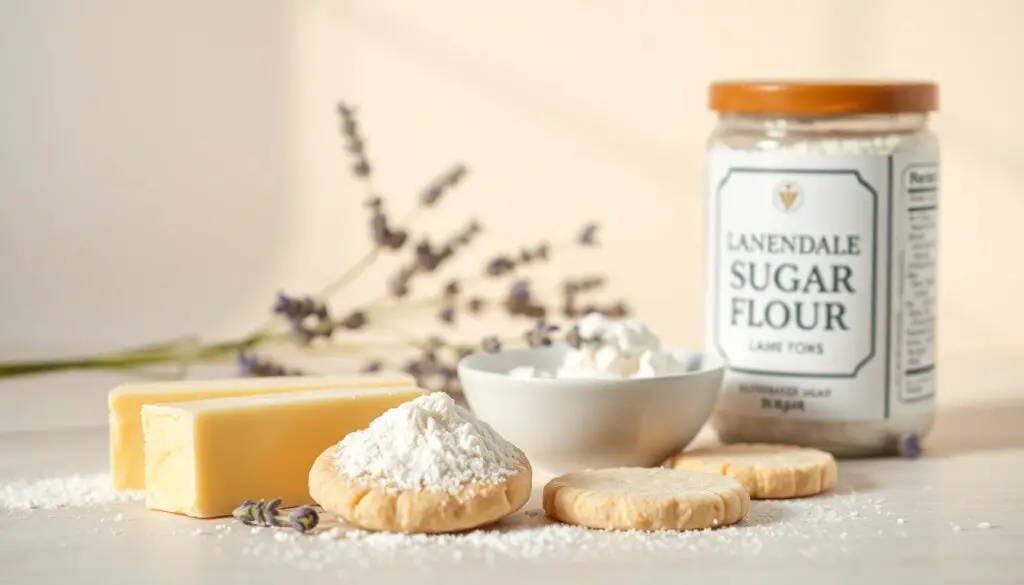
High-Quality Butter: The Foundation of Great Shortbread
Butter is the dough’s base. Choose European-style butter for its high fat content. Unsalted butter lets you adjust the salt. “Room-temperature butter mixes evenly into a smooth dough,” experts say. Softened butter is better than melted.
- 82%+ fat content for flaky layers
- No substitutes: Margarine changes texture
Choosing the Right Flour
All-purpose flour is common, but adding cornstarch (2 tbsp per cup) makes it tender. Rice flour is good for gluten-free options. Lower-protein flour prevents toughness. “Cornstarch cuts gluten development for cloud-like crumbs,” say pastry chefs.
Sweeteners: Traditional vs. Modern Options
Confectioners’ sugar is traditional for its fine texture. Brown sugar adds moisture for chewy edges. Modern recipes might use honey or maple syrup, but classic recipes stick to sugar ratios. The 3:2:1 flour-butter-sugar ratio is key for balance.
Optional Flavor Enhancers
Zest of lemon or orange brightens the flavor. Vanilla or almond extract (¼ tsp max) adds depth. Spices like cinnamon or nutmeg add a pinch of flavor. Always taste before baking.
Kitchen Tools You’ll Need
Making easy shortbread cookies starts with the right tools. Even beginners can succeed with basics like mixing bowls and baking sheets. Here’s what to gather before you begin.

Basic Equipment for Beginners
Essentials include:
- Baking sheet: For even heat distribution.
- Measuring cups and spoons: Ensure precise ingredient ratios.
- Silicone baking mat or parchment paper: Prevent sticking and cleanup.
- Wooden spoon or hand mixer: To blend butter and flour smoothly.
- Wire cooling rack: Let cookies cool without becoming soggy.
Nice-to-Have Tools for Enthusiasts
Elevate your baking with extras like:
- Stand mixer: Cream butter faster for a lighter texture.
- Shortbread molds or cookie cutters: Shape simple shortbread cookies into stars or hearts.
- Embossed rolling pin: Add intricate patterns before baking.
No stand mixer? A hand mixer works fine. Focus on essentials first—quality tools come later as your skills grow. With these tools, even first-timers can create bakery-quality easy shortbread cookies.
Preparing Your Kitchen and Ingredients
Perfect homemade shortbread cookies start with organized prep. Follow these steps to ensure your simple shortbread cookies turn out crisp and buttery:
- Butter Prep: Room temperature butter ensures smooth dough. If chilled, slice butter into 1-inch pieces and microwave at 50% power in 5-second bursts. Flip pieces between bursts until soft but not melted.
- Measure First: Use dry measuring cups for flour. Scoop and level to avoid overmeasuring, which can dry out the dough.
- Clear Workspace: Clear a flat surface for rolling dough. Keep tools like cutters and parchment paper within reach.
- Oven Check: Preheat to 320°F (160°C). Verify with a thermometer for accuracy.
- Storage Ready: Place wire racks on the counter. Prepare airtight containers for storage or freezing.
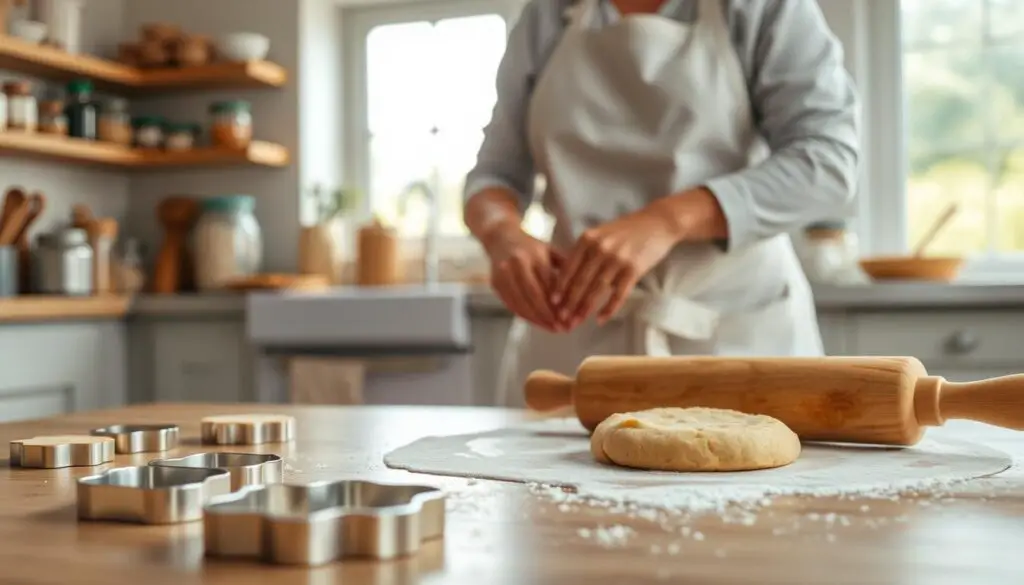
Simple shortbread cookies demand attention to detail. Take 10 minutes to organize tools and ingredients. Properly prepped butter and a ready oven mean less stress. Once everything’s set, you’re one step closer to golden-brown perfection. Every ingredient and tool in place ensures that signature melt-in-your-mouth texture.
Step-by-Step Traditional Shortbread Cookies Recipe
Learn the traditional shortbread recipe with this simple guide. Follow these steps to make the soft, buttery texture that shortbread is famous for.

Measuring and Mixing the Dough
Start by mixing 1 cup butter, ½ cup cornstarch, 1 cup icing sugar, and 2 tsp vanilla in a stand mixer. Use a paddle attachment until it’s light and fluffy. Then, add 3 cups flour slowly, mixing just until it comes together. Don’t overmix, as it can make the dough tough.
Proper Chilling Techniques
- Shape the dough into a log or disc, wrap it tightly in plastic, and chill for at least 1 hour (up to 4 days).
- Chilling the dough keeps it from spreading, giving it the perfect crumbly texture.
Rolling and Cutting Methods
Roll the chilled dough to ½-inch thickness on a floured surface. Use cookie cutters or slice logs into ½-inch rounds. For the iconic wedge shape, cut triangles from a baked slab.
Creating Decorative Patterns
Before baking, score the dough with a knife for grid patterns or press fork tines vertically and horizontally to mimic the classic “shortbread fingers.” Add sugar crystals for sparkle before baking.
Follow these steps for a shortbread cookies recipe that delivers rich buttery flavor every time. Adjust shapes and decorations to make batches uniquely yours.
Baking Times and Temperatures: Getting It Just Right
Perfect easy shortbread cookies start with the right oven settings. Aim for 325–350°F (160–175°C) for slow, even baking. Over 350°F can cause edges to burn before the center sets. For delicious shortbread recipe success, follow this guide:
- Temperature: 325°F (160°C) for thicker rounds or 350°F (175°C) for thinner cookies
- Time: 20–30 minutes total. Rotate the pan halfway through baking for even browning
- Position: Place dough on the middle rack to avoid hot spots
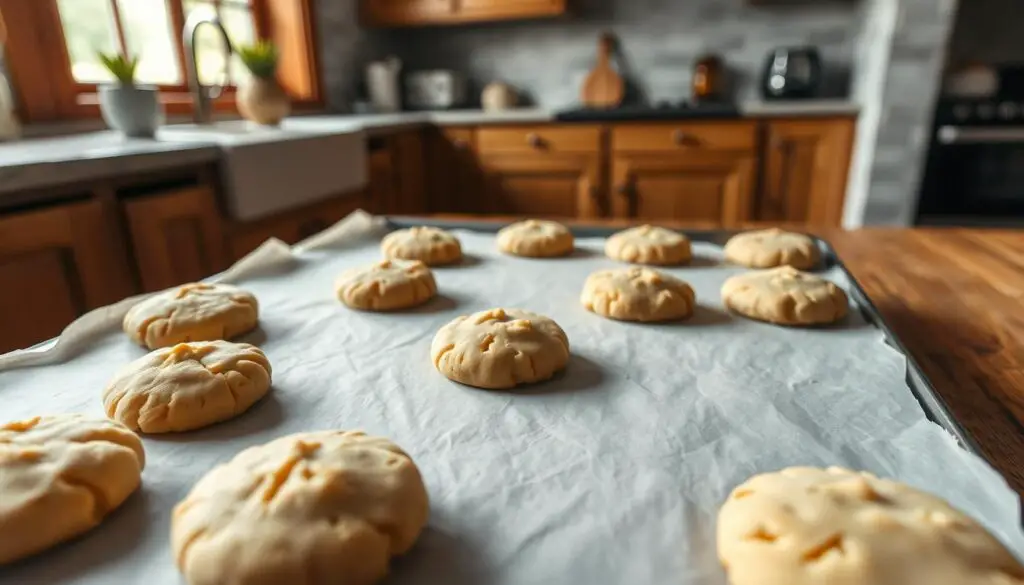
Check cookies when edges turn pale golden. Overbaking dries them out—stop when the center feels firm to the touch. For crispier results, bake an extra 5 minutes. Cooling is key: let them rest on the pan for 10 minutes before transferring to a rack.
“Shortbread should look almost undone in the center when removed—resist the urge to overbake!”
Thicker Scottish-style cookies may take 25–30 minutes, while thin rounds finish in 15–20. Adjust based on your oven’s behavior. Always test a single cookie first to calibrate timing. Proper baking transforms simple ingredients into the melt-in-your-mouth texture this classic dessert is known for.
How to Tell When Your Shortbread Cookies Are Done
Knowing when to take your shortbread cookies out of the oven is key. Here are some tips to help you avoid overbaking or underbaking. This way, you can enjoy perfectly cooked classic shortbread.
Visual Cues for Perfect Doneness
- Edges: A golden halo around the edges means they’re ready. The bottom should just start to brown, without any darker spots.
- Surface: The top should be pale but not shiny anymore. If it’s dry and matte, the butter has cooked well.
- Shape Check: Thicker shapes take longer. A 1cm-thick slice might still look pale on top but should have golden edges.
Texture Tests for Shortbread Cookies
Gently press the center—it should bounce back but not feel doughy. After baking, cookies firm up a bit due to carryover heat. If they crack easily when touched, they’re overbaked.
Pro tip: Rotate the pan halfway through baking for even browning. Let them cool for 5 minutes on the sheet before moving them to a rack. This helps prevent sogginess from steam trapped under them.
Cooling and Storing Your Homemade Shortbread Cookies
To keep your homemade shortbread cookies fresh, cool and store them right. Even the best recipe can go wrong if not cooled and stored correctly. Follow these tips to enjoy every cookie for days or even months.
Proper Cooling Methods
Cooling is key for the perfect texture. After baking:
- Let cookies rest on the baking sheet for 2–5 minutes to firm up without breaking.
- Transfer to a wire rack to finish cooling. This prevents moisture buildup and keeps them crisp.
Storage Containers That Maintain Freshness
Choose the right containers to preserve texture:
- Airtight glass jars or metal tins keep cookies fresh for 1–2 weeks at room temperature.
- Layer with parchment paper to avoid sticking. Add desiccant packets in humid climates.
- Refrigerate for up to 3–4 weeks in sealed containers.
Freezing Tips for Long-Term Storage
Freeze for holiday prep or bulk baking:
- Wrap cooled cookies tightly in parchment and foil before freezing.
- Seal in freezer-safe bags for up to 3 months. Label with dates for easy tracking.
- Thaw at room temperature—no microwaves—to retain texture.
Proper storage lets homemade shortbread cookies stay delicious whether enjoyed now or saved for special occasions.
Delicious Variations on the Classic Recipe
The classic shortbread recipe is loved for its simplicity. But its buttery base invites creativity. Try adding citrus zest or chocolate coatings to keep the 1:2:3 sugar-butter-flour ratio. These changes bring new flavors to the table.
- Vanilla Bean Twist: Split a vanilla bean and scrape seeds into the dough for an intense flavor boost.
- Lemon Zest Surprise: Stir in 1 tsp lemon zest for a bright, citrusy contrast to the buttery base.
- Chocolate-Dipped Luxury: Dip cooled cookies in melted dark chocolate for a rich finish—try 70% cocoa for depth.
- Spiced Holiday Magic: Mix ½ tsp cinnamon + nutmeg into dough for festive warmth without altering texture.
“The best delicious shortbread recipe variations enhance without overwhelming the original’s charm,” says pastry chef Emma Hart of Baking Artisan.
Try adding toppings like sea salt flakes or crushed nuts. But keep mix-ins under ¼ cup per batch to avoid crumbling. For a savory twist, mix in 1 tbsp chopped fresh rosemary and ¼ cup grated Parmesan. Always chill the dough for 1 hour before baking to keep the classic shortbread recipe’s crumbly texture. With over 15 proven variations, there’s a version for every palate!
Easy Shortbread Cookies for Special Dietary Needs
It’s easy to make easy shortbread cookies for different diets without losing flavor. You can make them gluten-free, vegan, or sugar-free with a few changes.
Gluten-Free Shortbread Options
Use a gluten-free mix instead of wheat flour. Try Bob’s Red Mill 1:1 Gluten-Free Baking Flour. Add 1 tsp xanthan gum to keep them from crumbling.
Bake them at 325°F for 14–18 minutes. This will make them soft and tender.
Vegan Shortbread Alternatives
Use vegan margarine or coconut oil instead of butter. Choose powdered sugar made from cane or coconut nectar for sweetness.
Reduce baking time by 2–3 minutes to avoid them getting too brown. Chill the dough for 30 minutes before baking for better results.
Reduced-Sugar and Keto-Friendly Versions
Reduce sugar by half and use 1/4 cup erythritol or allulose instead. Add 2 tablespoons almond flour to keep them moist.
Keto versions need 1/2 cup coconut sugar and more butter for extra richness. Bake at 300°F for 16 minutes.
These tweaks keep the cookies true to their original taste. Always check the dough’s texture and adjust baking times as needed. Every bite will still be buttery and crumbly.
Pairing Your Buttery Shortbread with Beverages
Pair buttery shortbread cookies with drinks that bring out their rich flavors. The simple nature of traditional shortbread makes it perfect for pairing. Whether it’s tea, wine, or something else, the right drink can make each bite special.
Traditional Tea Pairings
- Earl Grey: The bergamot notes in Twinings Earl Grey complement the buttery base.
- English Breakfast Tea: A robust black tea like Tetley balances shortbread’s sweetness without overpowering it.
- Green Tea: Matcha-infused shortbread pairs well with Sencha or jasmine tea for a light contrast.
Coffee and Espresso Combinations
Light roast coffees like Starbucks Veranda Blend highlight shortbread’s subtle sweetness. Dark roasts or espresso shots create bold contrasts. For creaminess, enjoy with a vanilla latte or white mocha.
Wine and Dessert Liqueur Suggestions
Rich dessert wines like Château d’Yquem Sauternes or Ruffino Vin Santo enhance dark chocolate shortbread. Pair citrusy liqueurs like Grand Marnier with lemon zest variations. For a classic combo, try port wine with traditional shortbread.
“A well-paired drink turns shortbread from snack to celebration.”
Try out these pairings to find your favorite. Whether you’re enjoying a tea ritual or hosting a tasting party, the right drink makes buttery shortbread even more appealing.
Common Mistakes When Making Shortbread (And How to Avoid Them)
Mastering scottish shortbread cookies means avoiding common mistakes. Even small errors can mess up the buttery, crumbly texture everyone loves. Here’s how to fix them:
- Cold Butter Catastrophe: Always use room-temperature butter. Cold butter makes mixing hard, leading to cracks or uneven baking. Let it sit at room temp for 30 minutes before starting.
- Overmixing: Mix dough just until ingredients combine. Overmixing makes cookies tough. Stop mixing once dry ingredients are incorporated.
- Skipping Chilling: Chill dough for 30 minutes. This step firms the butter, preventing spreading. Skip it and your cookies will flatten into a biscuit-like sheet.
- Wrong Oven Temp: Bake at 300°F (149°C) for 30 minutes. Higher temps burn edges while leaving centers doughy. Use an oven thermometer to confirm accuracy.
- Chalky Texture: Avoid extra cornstarch or potato starch unless the recipe specifies. These additives create off-putting flavors in traditional easy shortbread cookies.
“The best shortbread requires patience—not force. Respect the dough’s delicate balance.” — Baking Science Institute
Measure flour by spooning and leveling, not scooping. Scooping packs in excess flour, leading to dryness. For easy shortbread cookies, use a kitchen scale for accuracy. And never skip the 2-inch spacing on baking sheets—crowded cookies merge into one big mess.
Remember: 2 sticks of butter (225g) and precise ratios matter most. Adjust these steps, and you’ll never face crumbly disasters again.
Seasonal and Holiday Shortbread Cookie Ideas
Make your shortbread cookies recipe a year-round delight. The traditional shortbread recipe is a canvas for all seasons. These ideas keep shortbread cookies a hit at every celebration.
Holiday Magic: Turn your kitchen into a workshop for festive treats. Cut dough into snowflakes, stars, or gingerbread shapes. Dip edges in colored sugars or drizzle with chocolate for holiday flair. For Hogmanay traditions, bake traditional shortbread recipe triangles called petticoat tails. Add crushed candy canes to dough for subtle peppermint notes.
- Decorate with sprinkles or candied canes for Christmas
- Try thumbprint cookies filled with cranberry jam
- Top with edible gold leaf for luxury gifts
Summer & Spring Flavors: Lighten the shortbread cookies recipe with citrus zest. Mix in lavender or rosemary for floral notes. Add dried berries or mint leaves for freshness. Sandwich layers with lemon curd or strawberry jam for seasonal bites.
Gift-Giving Tips: Package cookies in tins or cellophane bags. Layer with parchment between sheets to prevent sticking. Attach handwritten tags with serving suggestions. For gifting, pair with tea or cocoa in gift baskets. Shortbread’s dense texture holds up well in gifts, even shipped long-distance.
From winter whites to summer citrus, shortbread’s buttery base adapts to every occasion. Its durable nature makes it perfect for gifting, whether wrapped in foil or tucked into tins. These ideas transform a classic into a year-round treat without losing its buttery charm.
Why Homemade Shortbread Cookies Beat Store-Bought Every Time
Homemade shortbread cookies are a clear winner over store-bought ones. They taste better and hold a special tradition. Making your own delicious shortbread recipe lets you control every ingredient. You get to enjoy real butter, not additives or preservatives.
Homemade cookies use simple, fresh ingredients. Commercial brands often add stabilizers or artificial flavors to last longer.
Cost savings surprise: Making a batch of homemade shortbread cookies for 36 servings costs the same as an 8-pack of store-bought—around $4.29. That’s 75% more cookies for the same price! Plus, homemade batches take just 15 active minutes to prep, proving efficiency beats convenience.
- Freshness: Store-bought cookies can sit for months; homemade versions stay fresh for a month when stored properly.
- No preservatives: No artificial additives in your delicious shortbread recipe.
- Customization: Add vanilla, nuts, or sea salt—your recipe, your rules.
“Homemade shortbread has a buttery richness store versions can’t match,” said testers. “The texture is crumbly-perfect, not dry.”
Traditional methods like Alice Medrich’s double-bake technique or King Arthur’s flaky texture tricks highlight how homemade recipes adapt to your preferences. Even Ina Garten’s labor-of-love method pays off in flavor. Every batch becomes a sensory win—golden-browned, melt-in your mouth, and made with care.
Baking connects you to a centuries-old tradition. When you shape dough into classic rounds or festive shapes, you’re part of a legacy. Plus, sharing homemade treats feels like love on a plate—something a boxed gift can’t replicate.
Conclusion: Mastering the Art of Shortbread Cookies
Scottish shortbread cookies have a rich history, dating back centuries. They started in medieval kitchens and are now loved worldwide. The recipe is simple, with just three main ingredients. But, adding rice flour or caster sugar can create many variations.
When baking, use high-quality ingredients like European butter and superfine sugar. Chilling the dough, baking at 325°F, and cooling it fully are key. This ensures the cookies have that perfect crunch.
Many bakers, from Delia Smith to those making gluten-free versions, have their own take on shortbread. You can try festive shapes, add flavors, or use different coatings. This keeps the tradition alive while making it your own.
Sharing your shortbread online or in gift tins connects you to those who love it. Even small changes, like using rice flour or almond flour, can make your cookies special. Shortbread is great with tea, liqueur, or coffee, showing its versatility.
So, bake with confidence, store your cookies well, and let tradition guide you. The world always wants something sweet, and a bit of history.
FAQ
What ingredients are essential for making classic shortbread cookies?
You’ll need high-quality butter, all-purpose flour, and sugar. Use the 3:2:1 ratio of flour to butter to sugar for the best taste. Adding vanilla or almond extract can also enhance the flavor.
Why is it important to use high-quality butter for shortbread?
High-quality butter, especially European-style, gives shortbread its rich taste and soft texture. Choose unsalted butter to control the salt in your cookies.
How can I tell if my shortbread cookies are done baking?
Look for slightly golden edges and a pale top. They should feel set but still soft to the touch. A soft texture will firm up as they cool.
What are some popular variations of shortbread cookies I can try?
Try adding citrus zest, nuts, or chocolate chips. You can also use lavender, rosemary, or spices like cinnamon. Chocolate or decorative sugars can add a nice touch.
How should I store homemade shortbread cookies to maintain freshness?
Keep them in airtight containers to stay fresh. For longer storage, freeze them. Proper wrapping prevents freezer burn.
Can I make gluten-free shortbread cookies?
Yes, use gluten-free flour blends or almond flour. Adjust the recipe for the right texture. Follow a reliable gluten-free shortbread recipe.
What beverages pair well with buttery shortbread cookies?
Tea or coffee are classic choices. Dessert wines and liqueurs add a sophisticated touch. Try different drinks to find your favorite!
How do I ensure my shortbread has the right texture?
Use room temperature butter for creaming. Avoid overmixing and chill the dough before baking. Watch baking times and temperatures to avoid overcooking.